Insectopedia (49 page)

Hooke wondered aloud about the optics of his “drone-fly” (“How exceeding curious and subtile must the component parts of the medium that conveys light be, when we find the instrument made for its reception or refraction to be so exceedingly small?”),
19
but it was van Leeuwenhoek—thirty years later—who first realized that the image transmitted to the fly’s brain was fractured, that each facet of the eye captured its own image. Van Leeuwenhoek recorded his account in a
breathless letter to the Royal Society of London, published in 1695, an age when the arts and sciences were still negotiating their formal separation. “What I observed by looking into the microscope,” he informed his colleagues, “were the inverted images of the burning flame: not one image, but some hundred images. As small as they were, I could see them all moving.”
20
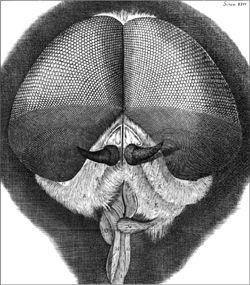
Almost exactly two centuries later, Sigmund Exner, the eminent physiologist who would guide his young nephew Karl von Frisch in setting up the family natural history museum on the shores of Lake Wolfgang, was completing
The Physiology of the Compound Eyes of Insects and Crustaceans
, the first authoritative account of insect vision and a groundbreaking monograph whose claims survive intact to this day.
21
Exner was an assistant to Ernst Brücke, the professor of physiology at the Institute of Physiology in Vienna who persuaded Sigmund Freud to reject neuroscience for neurology. Exner and Freud were colleagues at the institute, both under the mentorship of Brücke, and like Freud, Exner was at the same time subject to the compulsion of vision and fascinated by its mechanics. With great care and labor, he succeeded in taking a photograph through the compound eye of the firefly
Lampyris
, but the image he saw was quite different from van Leeuwenhoek’s.
How could the multiply-fractured compound eye, with its numerous facets, produce only one image, and how could that image be erect rather than inverted, like the image that travels to the brain from the eye of both the fly and the human being?
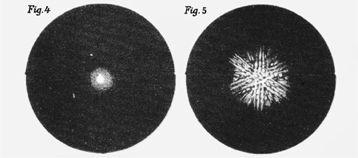
Although the difference is not externally evident, Exner knew that there are two distinct types of compound eyes. The compound eye of the fly examined by van Leeuwenhoek is made up of multiple light-gathering units, called ommatidia, each of which is itself a single, independent eye that collects light from just a narrow section of the animal’s field of view. Exner discovered that in this type of compound eye—called an apposition eye—light passes through the hexagonal facet lens into the crystalline cone, with its sheath of pigmented cells that block ambient light from adjacent ommatidia, down the cylindrical light-sensitive rhabdom, which houses the eight photoreceptive retinal cells, and all the way to the nerve cells that transmit the image to the optic ganglion and into the brain, where the inverted mosaic produced by the retinal cells is turned into a single erect image.
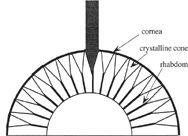
But Exner also knew that like moths and many other insects that fly at twilight and after dark, the firefly, whose retinal image he reproduced in his 1891 monograph, is nocturnal and possesses what is called a superposition eye, an instrument 100 times more light sensitive than the apposition eye of diurnal insects.
Rather than being separated into individual ommatidia, the retina of the superposition eye is a single sheet, and it lies deep in the eye, above
a clear zone across which light is focused. We might say that in the superposition eye the ommatidia cooperate: the image falling on its retina at any point is the product of multiple lenses.
22
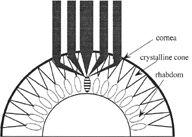
But the real puzzle was how such optics succeeded in producing an erect image. And it was Exner, working on this problem throughout the 1880s without tools for definitive demonstration, who figured out that the rhabdom of the superposition eye functions as a two-lens telescope, redirecting the rays of light so they cross each other within the cylinder and reverse the image. “Clearly,” says the biologist Michael Land, “we are dealing here with something quite out of the ordinary.”
23
The views below, taken by Land and Dan-Eric Nilsson, demonstrate the difference between the images produced by the two types of compound eyes. The inverted apposition view, on the left, was photographed through the cornea of a robber fly; the rather blurry image (of Charles Darwin) on the right is seen through that of a firefly.
24
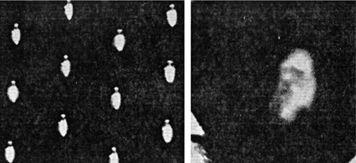
The number of ommatidia in a compound eye varies enormously, from single digits in some ants to more than 30,000 in some dragonflies.
As we might expect, the more ommatidia that are present, the better the eye’s resolution. But even the best compound eyes cannot focus, and cannot move in their sockets (and so demand that the insect swivel its entire head to shift its view), and, except at very close range, compound eyes have relatively very poor acuity. Where insect eyes do excel, as anyone who’s tried to snatch a fly or squish a mosquito knows very well, is in their sensitivity to movement. Flying insects in particular often have an extraordinarily wide field of vision, as great as 360 degrees in those dragonflies whose eyes meet at the top of the head.
But this is not the insects’ only basis for motion detection. To compensate for the animals’ accelerated flicker-fusion frequency—the rate at which a moving image appears as one continuous flow rather than a series of discrete events like those on the pages of a flip-book—a movie designed for (or by) a fly would run five times faster than the standard twenty-four frames per second. Flies, this suggests, live in a world that moves much faster than ours. They are born and they die within days, weeks, or months, not decades. They occupy a different plane from us. Not only is it a plane in which acuity, pattern, and color are distinctive, but it is also one in which space-time is lived in another register. If we think of our senses as mediating our relationship with the world around us, we might wonder about the perceptual, intellectual, and emotional lives of beings, including human beings, whose sense organs differ from our own. Some of this mystery can be captured by blurry pictures and plastic masks. Some of it should be allowed to throw our own perceptual certainties into relief.
This thought leads to one more view from an insect’s eye. And this time it’s not a photograph. It’s a different kind of re-creation, and it was made in the 1930s by the great Estonian biologist-philosopher Jakob von Uexküll. In the forests through which von Uexküll wanders, all sensate beings are subjects, occupying their own
Umwelt
, an environment defined by the limits and possibilities of their senses.
25
All beings live in their own time worlds and space worlds, too, distinct worlds in which both time and space are subjectively experienced through sense organs that differ radically among beings and produce radically different experiences. “The subject sways the time of his own world,” von Uexküll writes. “There is no space independent of subjects.”
26
Above is a room as sensed by a housefly. Von Uexküll divides it into “functional tones.” Everything except the plates, the glasses, and the lamp is a “running tone,” a surface on which the fly can run. The heat of the light pulls the animal in; the food and drink on the table hold fast its taste-bud-equipped feet. I don’t believe that the universe of a fly is quite this bland, but nonetheless there is an important insight here. Remember the black-eyed susans? “There can be no doubt,” von Uexküll writes, “that a fundamental contrast prevails everywhere between the environment which we see spread around animals, and the
Umwelten
that are built up by the animals themselves and filled up with the objects of their own perception.”
27
Parts of these alien
Umwelten
arise from simple motor responses, the kind of thing that Jean-Henri Fabre called instinct. But others are the result of trial and error, of judgment, of “repeated personal experiences.” These are “free subjective products,” and like time and space, they are experiential and individualized.
28
This concept doesn’t seem too hard to grasp: that the world is multiple and is different for different beings; that our world is our world and theirs is theirs; that when we meet, it is across and between distinct, intersecting realities. Actually, isn’t this the road we began to travel when we donned the Lucite mask? And now that
we’re here, doesn’t it look as if these masks are finally less about the promise of communication and communion, about seeing as the animal sees, than they are about the fact of unbridgeable difference?
Well, continues von Uexküll, hammering his point home, although things exist objectively in the physical world, they never appear in any being’s
Umwelt
as their objective selves. All animals, ourselves included, know these objective things only as perceptual clues with functional tones—and “this alone makes them into real objects, although no element of the functional tone is actually present in the original stimuli.” And so he continues, on and on, getting deeper and deeper into the flow of his argument (so deep, in fact, that it is hard not to keep quoting him), “we ultimately reach the conclusion that each subject lives in a world composed of subjective realities alone, and that even the
Umwelten
themselves represent only subjective realities.”
29
All of us, all the people and all the animals, live in worlds of our own making, more or less complex, more or less stimulating, similarly subjective.
